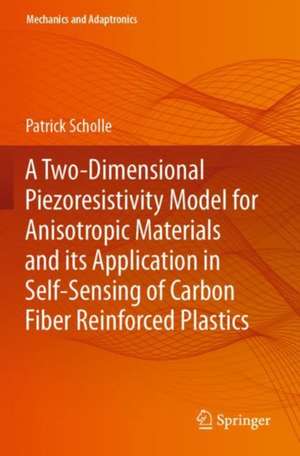A Two-Dimensional Piezoresistivity Model for Anisotropic Materials and its Application in Self-Sensing of Carbon Fiber Reinforced Plastics: Mechanics and Adaptronics
Autor Patrick Scholleen Limba Engleză Paperback – 3 mar 2024
This thesis works on the topic of fiber-reinforced plastics and discusses the measurement of strain with embedded sensors. Embedding sensors into a structure fundamentally poses challenges arising from the differences in mechanical properties of sensor and structure. This thesis works on the research area of Self-Sensing, where these challenges are overcome by using carbon fibers for both load-carrying and strain-sensing functions. Starting with a literature review, this thesis proposes three research hypotheses, which are targeted to describe the Self-Sensing properties of unidirectional carbon fiber reinforced plastics (CFRPs) for strain measurements. These hypotheses assume, that the electric anisotropy of the material results in a complex voltage distribution within a Self-Sensing specimen. In order to discuss this point further, a two-dimensional piezoresistivity model based on the Laplace equation is introduced. The developed model newly allows to quantify the electricpotential changes in specimens with arbitrary geometrical dimensions and electric anisotropy.
Furthermore, this thesis discusses a set of experimental results on the piezoresistive properties of unidirectional CFRP made with the pultrusion process. Overall, the results of the experiments indicate that the most repeatable results are obtained for specimens with electric contacts at their cut-end. This approach allows to manufacture Self-Strain-Sensing rods with a gauge factor of approximately 1.9 that can be used in a multifunctional manner for both load-carrying and strain-sensing purposes. Furthermore, a novel measurement setup is developed, which allows to acquire the electric potential distribution on the surface of electrical conductors with very high spacial resolution. This experimental setup newly reveals that the current flow in specimens can be more complex than assumed in a two-dimensional model.
| Toate formatele și edițiile | Preț | Express |
|---|---|---|
| Paperback (1) | 776.83 lei 39-44 zile | |
| Springer Nature Switzerland – 3 mar 2024 | 776.83 lei 39-44 zile | |
| Hardback (1) | 947.35 lei 3-5 săpt. | |
| Springer Nature Switzerland – 3 mar 2023 | 947.35 lei 3-5 săpt. |
Preț: 776.83 lei
Preț vechi: 1022.15 lei
-24% Nou
Puncte Express: 1165
Preț estimativ în valută:
148.65€ • 158.95$ • 123.94£
148.65€ • 158.95$ • 123.94£
Carte tipărită la comandă
Livrare economică 14-19 aprilie
Preluare comenzi: 021 569.72.76
Specificații
ISBN-13: 9783031237683
ISBN-10: 3031237684
Pagini: 196
Ilustrații: XV, 196 p. 159 illus., 146 illus. in color.
Dimensiuni: 155 x 235 mm
Ediția:2023
Editura: Springer Nature Switzerland
Colecția Springer
Seria Mechanics and Adaptronics
Locul publicării:Cham, Switzerland
ISBN-10: 3031237684
Pagini: 196
Ilustrații: XV, 196 p. 159 illus., 146 illus. in color.
Dimensiuni: 155 x 235 mm
Ediția:2023
Editura: Springer Nature Switzerland
Colecția Springer
Seria Mechanics and Adaptronics
Locul publicării:Cham, Switzerland
Cuprins
1. Introduction.- 2. State of the Art of Embedded Strain Sensors for Fiber Reinforced Plastics.- 3. Electrical Homogeneity and Fiber Waviness: Predominant Factors for Self-Strain-Sensing Carbon Fiber Structures – A Literature Study.- 4. Concerning the Influence of Current Inhomogeneity on Self-Strain-Sensing Properties of Carbon Fiber Reinforced Plastics.- 5. Direct Measurement of the Potential Distribution on Conducting Surfaces.- 6. Implementation Aspects of Self-Strain-Sensing Carbon Fiber Rods.- 7. Summary Conclusions and Outlook.
Notă biografică
Patrick Scholle received his doctorate degree from the Technische Universitaet Braunschweig working on Fiber Reinforced Plastics (FRPs). During this time, he worked on different projects where he developed novel manufacturing techniques for FRPs and analyzed extensively the electrical properties of Carbon Fiber Reinforced Plastics, publishing a total of five peer reviewed articles on these subjects (ORCiD-ID:0000-0003-4476-6983). Before joining the Technische Universitaet Braunschweig for his PhD studies, he finished an apprenticeship as an industrial mechanic and obtained his Bachelors degree from the University of Applied Sciences Osnabrueck. Afterwards, he pursued his Masters degree at the Technische Universitaet Braunschweig which included a semester as a visiting researcher at Carleton University in Ottawa, Canada, to conduct research for his masters thesis.
Textul de pe ultima copertă
This thesis works on the topic of fiber-reinforced plastics and discusses the measurement of strain with embedded sensors. Embedding sensors into a structure fundamentally poses challenges arising from the differences in mechanical properties of sensor and structure. This thesis works on the research area of Self-Sensing, where these challenges are overcome by using carbon fibers for both load-carrying and strain-sensing functions. Starting with a literature review, this thesis proposes three research hypotheses, which are targeted to describe the Self-Sensing properties of unidirectional carbon fiber reinforced plastics (CFRPs) for strain measurements. These hypotheses assume, that the electric anisotropy of the material results in a complex voltage distribution within a Self-Sensing specimen. In order to discuss this point further, a two-dimensional piezoresistivity model based on the Laplace equation is introduced. The developed model newly allows to quantify the electric potential changes in specimens with arbitrary geometrical dimensions and electric anisotropy.
Furthermore, this thesis discusses a set of experimental results on the piezoresistive properties of unidirectional CFRP made with the pultrusion process. Overall, the results of the experiments indicate that the most repeatable results are obtained for specimens with electric contacts at their cut-end. This approach allows to manufacture Self-Strain-Sensing rods with a gauge factor of approximately 1.9 that can be used in a multifunctional manner for both load-carrying and strain-sensing purposes. Furthermore, a novel measurement setup is developed, which allows to acquire the electric potential distribution on the surface of electrical conductors with very high spacial resolution. This experimental setup newly reveals that the current flow in specimens can be more complex than assumed in a two-dimensional model.
Caracteristici
Provides a comprehensive review of the rapidly expanding field of Self-Sensing using piezoresistive properties of CFRPs Includes in-depth discussions on the electrical current flow in anisotropic conductors such as CFRP Introduces a novel measurement approach for the in-depth study of the current flow in CFRP and other materials









